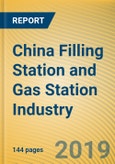It is Predicted that Gas Stations Will Mushroom in China in the Near Future Along With the Promotion and Application of Natural Gas Vehicles, Numbering Roughly 20,000 in 2025
It is only in recent years that ownership of motor vehicles, particularly automobiles has been soaring in pace with the development of the national economy and the improvement of people’s living standards in China. At the end of 2018, ownership of motor vehicles in China reached 327 million units including 240 million automobiles, and accordingly there were up to 110,000 filling stations and at least 9,000 gas stations respectively across the country.
In the Chinese filling station market, state-owned enterprises, private firms and foreign companies co-exist, among which the state-owned enterprises are represented by CNPC, Sinopec and CNOOC, which held a combined market share of approximately 52% in 2018, followed by private firms with 45% share and foreign companies less than 3% share.
In June 2018, the Special Management Measures (Negative List) for Foreign Investment Access (2018) was issued, which officially abolished the restriction that foreign filling station in possession of over 30 chains should have shares be controlled by Chinese side. As a result, foreign companies like Shell and BP stated expansion plans in China for the future. Shell is keen to operate 2,200 more filling stations in China by 2025; BP wants to add 1,000 filling stations in China over the next five years; Exxon Mobil and Total will follow suit and make their forays into the Chinese retailing market rapidly. In addition, private firms such as Shandong Dongming Petrochemical Group as well as state-owned enterprises like Sinochem Oil has expressed an interest in either newly increasing a great number of filling stations or developing franchised ones. It is expected that in 2025 there will be a total increase of nearly 30,000 filling stations over the corresponding figure in 2018.
As its refined oil retailing market is fully opened up, China’s reform of filling stations will usher in a new platform. With the prevalence of the “filling station + convenience store + charging station/pile” model, related companies actively collaborate on promotional pilots of charging/battery-swap services in filling stations. Examples include cooperation between CNPC and FAW, Sinopec and BAIC BJEV, and CNOOC and Potevio/State Grid. In the upcoming years, China’s filling stations will run at a “filling station + internet + N” model, becoming a service platform integrated with people, car and life.
In China, gas stations have a smaller scale than filling stations mainly because the country started late in natural gas vehicles, whose ownership is still less than 10 million units currently. Yet such clean eco-friendly vehicles are advocated by multiple policies. For instance, the Opinions on Accelerating the Use of Natural Gas, which was issued in 2017, suggests expediting the development of natural gas vehicles and vessels; the Notice of Preferential Vehicle and Vessel Tax Policies for Energy-saving and New-energy Vehicles and Vessels which was launched in July 2018, specifies that natural gas vehicles should be listed as energy-saving vehicles where vehicle and vessel taxes are reduced by half. It is predicted that gas stations will mushroom in China in the near future along with the promotion and application of natural gas vehicles, numbering roughly 20,000 in 2025.
China Filling Station and Gas Station Industry Report, 2018-2025 highlights the following:
China filling station industry (policies, market size, competitive pattern, chain operation and development trends);
China refined oil market (supply and demand, import and export, price and development trends);
China motor vehicle/automobile market (ownership, structure, and number of supporting filling stations);
Global and China natural gas vehicle industry (policy environment, market size, gas station ownership and distribution, competitive pattern, development trends, etc.);
Major Global and Chinese operators (Shell, BP, ExxonMobil, Total, Sinopec, CNPC, CNOOC, Sinochem Oil and Dongming Petrochemical) (operation, production and sales of oil and gas, number of filling/gas stations and distribution, non-oil business, development strategy, etc.).
This product will be delivered within 3-5 business days.
Table of Contents
Companies Mentioned
- BP
- CNOOC
- CNPC
- Dongming Petrochemical
- ExxonMobil
- Shell
- Sinochem Oil
- Sinopec
- Total
Methodology

LOADING...








